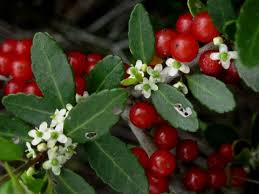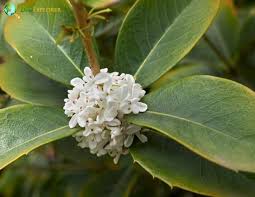The Holly Flower, with its evergreen leaves and striking red berries, has captured the hearts and imaginations of people around the world for centuries. Known botanically as Ilex, the holly flower belongs to a diverse genus of approximately 400 species, which can be found in various parts of the globe. Revered for its beauty and cultural significance, this charming plant has earned its place as a symbol of tradition and festivity, particularly during the holiday season.
One of the defining features of the holly flower is its distinct appearance. Its glossy, dark green leaves are often spiky and have serrated edges, adding a touch of drama to its already captivating presence. Paired with its vibrant red berries, the holly flower stands out as a beautiful contrast against the backdrop of winter’s muted colors. This natural combination has made holly a popular choice for ornamental purposes, adding a touch of festive elegance to wreaths, decorations, and bouquets during Christmas and other winter celebrations.
Throughout history, the holly flower has played a significant role in various cultures and traditions. Its evergreen nature, representing life and vitality during the cold winter months, has led to its association with the cycle of life and the continuity of nature. Ancient Romans and Celts revered the holly as a symbol of fertility, protection, and good fortune. Over time, the holly flower became closely intertwined with Christian traditions, and it is now widely regarded as a symbol of Christ’s crown of thorns, with the red berries symbolizing drops of his blood.
Beyond its symbolic significance, the holly flower also holds practical value. Its dense growth and thorny leaves make it an ideal choice for hedges and barriers, offering privacy and security in gardens and landscapes. Wildlife, particularly birds, find refuge in holly bushes, relying on the berries as a valuable source of food during harsh winters. The holly’s ecological importance goes hand in hand with its cultural prominence, making it a cherished addition to many landscapes worldwide.
In addition to its symbolic and practical attributes, the holly flower has also been associated with a variety of medicinal and mystical properties. Traditional herbalists have used holly in remedies for various ailments, including fevers, rheumatism, and digestive issues. It was also believed to have protective qualities and was hung in homes to ward off evil spirits. Such folklore and beliefs have contributed to the holly’s allure and enduring popularity through the ages.
Today, the holly flower remains a beloved and cherished plant, celebrated not only during the holiday season but also throughout the year. Gardeners continue to cultivate holly varieties for their ornamental appeal, and environmentalists recognize their ecological importance in supporting biodiversity. Whether adorning homes with festive wreaths or providing sanctuary for birds in the wild, the holly flower continues to enchant and inspire, reminding us of the beauty, resilience, and interconnectedness of the natural world.
Read Also: Night Flowers: All You Need To Know About
History And Significance Of Holly Flowers

The history of the holly flower is as rich and intriguing as its lush green foliage and vibrant red berries. Dating back thousands of years, this captivating plant has woven its way into the tapestry of numerous cultures, leaving an indelible mark on traditions and beliefs.
Holly’s origins can be traced back to ancient civilizations, where it held symbolic importance and was often associated with the winter solstice and other celestial events. In Roman mythology, holly was linked to the god Saturn, and during the festival of Saturnalia, people exchanged holly wreaths and branches as gifts of goodwill. The Celts also venerated holly, believing it to possess protective qualities, bringing luck and guarding against malevolent spirits.
With the spread of Christianity, the symbolism of the holly flower underwent adaptation to align with the new faith. Its evergreen nature, which represented life and vitality during the cold winter months, became associated with eternal life and the promise of Christ’s resurrection. The prickly leaves were seen as a reminder of Christ’s crown of thorns, and the red berries were likened to drops of his blood, further intertwining holly with religious significance.
In medieval and Renaissance Europe, holly was an essential component of Christmas celebrations. It adorned churches, homes, and public spaces, creating a festive atmosphere during the holiday season. The holly’s presence in medieval carols and Christmas-themed artwork solidified its place as an emblem of Yuletide joy and merriment.
The Victorian era further solidified the holly flower’s association with Christmas and other winter festivities. Queen Victoria and her husband, Prince Albert, popularized many Christmas traditions, including the decorating of Christmas trees and the use of holly wreaths. These customs spread throughout Britain and the United States, and holly became an integral part of the traditional Christmas décor.
In modern times, the holly flower continues to hold cultural and ecological significance. It remains a cherished emblem of the holiday season, symbolizing hope, joy, and the enduring spirit of celebration. Holly wreaths and garlands still grace doorways and mantelpieces, creating a warm and welcoming ambiance.
Beyond its cultural importance, holly also plays a crucial role in the ecosystem. Its dense foliage provides shelter and protection for various bird species, and its berries serve as a vital food source during the winter months when other sustenance is scarce.
The holly flower’s history and significance are deeply rooted in humanity’s connection with nature and the ever-changing cycles of life. From ancient rituals to modern-day festivities, holly continues to symbolize tradition, renewal, and the enduring spirit of hope. Its beauty and meaning have transcended time and borders, making it a truly timeless and beloved symbol worldwide. Whether adorning our homes or nurturing wildlife, the holly flower serves as a reminder of the wonder and interconnectedness of the natural world.
Types of Holly Flowers

Holly flowers encompass a diverse range of species and varieties, each possessing unique characteristics and attributes. While there are numerous species of holly, some of the most common and well-known types include:
1. English Holly (Ilex aquifolium): This is one of the most iconic holly species, often depicted in Christmas decorations and holiday imagery. It features glossy, dark green leaves with distinct spiky edges and bright red berries. English holly is native to Europe and is widely cultivated for ornamental purposes.
2. American Holly (Ilex opaca): Native to eastern North America, the American holly is similar to the English holly in appearance, with glossy, dark green leaves and red berries. It is a popular choice for landscaping and is also utilized for its wood, which is used in crafts and carpentry.
3. Chinese Holly (Ilex cornuta): Originating from China, this holly species showcases a unique twist—its leaves often have pointed “horns” or protrusions, giving it a distinctive appearance. Chinese holly bears bright red berries and is favored for its ornamental appeal in gardens and landscapes.
4. Japanese Holly (Ilex crenata): This holly species is known for its small, boxwood-like leaves and black or dark purple berries. It is a popular choice for hedges and topiaries due to its compact and easily pruned growth habit.
5. Inkberry (Ilex glabra): Unlike many other hollies, the inkberry is a deciduous species native to eastern North America. It features dark green, lance-shaped leaves and black, persistent berries. It is commonly used in wetland restoration and landscaping projects.
6. Dwarf Holly (Ilex vomitoria ‘Nana’): As the name suggests, this is a compact and low-growing holly variety. It is native to the southeastern United States and is valued for its attractive foliage and bright red berries.
7. Blue Holly (Ilex x meserveae): This holly is a hybrid between the English holly and the Chinese holly. It is known for its blue-green leaves and vibrant red berries, which make it a popular choice for ornamental landscaping.
8. Possumhaw Holly (Ilex decidua): Another deciduous holly species, the possumhaw holly is native to the southern United States. It boasts striking orange to red berries that persist through winter, adding a pop of color to the landscape.
9. Yaupon Holly (Ilex vomitoria): Native to the southeastern United States, the yaupon holly is an evergreen shrub or small tree with small, leathery leaves and red berries. It is utilized in landscaping and is also the only holly species native to North America that contains caffeine.
These are just a few examples of the many holly species and varieties found across the globe. Whether for their ornamental value, ecological significance, or cultural importance, hollies continue to captivate and enchant people of all ages and backgrounds.
Read Also: All You Need To Know About Sweet William Flowers
Uses of Holly Flowers

The holly flower and its various parts have been utilized for a wide range of practical, cultural, and symbolic purposes throughout history. Its versatility and significance have made it a valuable plant with numerous uses. Some of the most notable uses of the holly flower include:
1. Ornamental Purposes: Perhaps the most well-known use of holly is for ornamental decoration, particularly during the Christmas season. Holly’s glossy green leaves and vibrant red berries make it a popular choice for creating festive wreaths, garlands, and centerpieces that adorn homes, churches, and public spaces during the holiday festivities.
2. Landscaping and Gardening: Many holly species and varieties are cultivated for their aesthetic appeal and their ability to enhance landscapes and gardens. Holly shrubs and trees are often used as hedges, privacy screens, and borders, providing year-round greenery and beauty to outdoor spaces.
3. Wildlife Attraction: Holly plants play a vital role in supporting wildlife, particularly birds. The berries of holly are a valuable food source for various bird species during the winter months when other food options may be scarce. Holly bushes can provide shelter and nesting sites for birds, contributing to biodiversity and ecological balance.
4. Traditional Medicine: Some holly species have been used in traditional herbal medicine for various purposes. Certain parts of the holly plant, such as leaves and berries, were believed to possess medicinal properties and were used to treat ailments like fevers, rheumatism, and digestive issues.
5. Symbolism and Traditions: Throughout history, the holly flower has been imbued with symbolic significance and has played a role in various cultural and religious traditions. It has been associated with themes of renewal, life, protection, and the promise of a new beginning, especially during winter celebrations and religious observances.
6. Woodworking and Crafts: Holly wood, particularly from American holly (Ilex opaca), is prized for its fine texture and smooth, pale color. It has been used in woodworking, carving, and cabinetry to create intricate designs and decorative elements. The wood is also favored for crafting small items such as walking sticks, tool handles, and jewelry.
7. Landscape Restoration: Certain holly species, like the inkberry holly (Ilex glabra), have ecological importance in landscape restoration projects. They are utilized in wetland restoration efforts to stabilize soil, control erosion, and provide habitat for wildlife.
8. Culinary Use: While holly berries are generally considered toxic to humans, they have been used in some traditional recipes to make preserves, jellies, and decorative accents for special occasions. However, it is essential to note that consuming holly berries can be dangerous and is not recommended.
Overall, the holly flower’s uses are a testament to its enduring cultural significance, ecological importance, and beauty, making it a cherished and cherished plant in various aspects of human life.
Read Also: How to Make Your Keychain at Home
